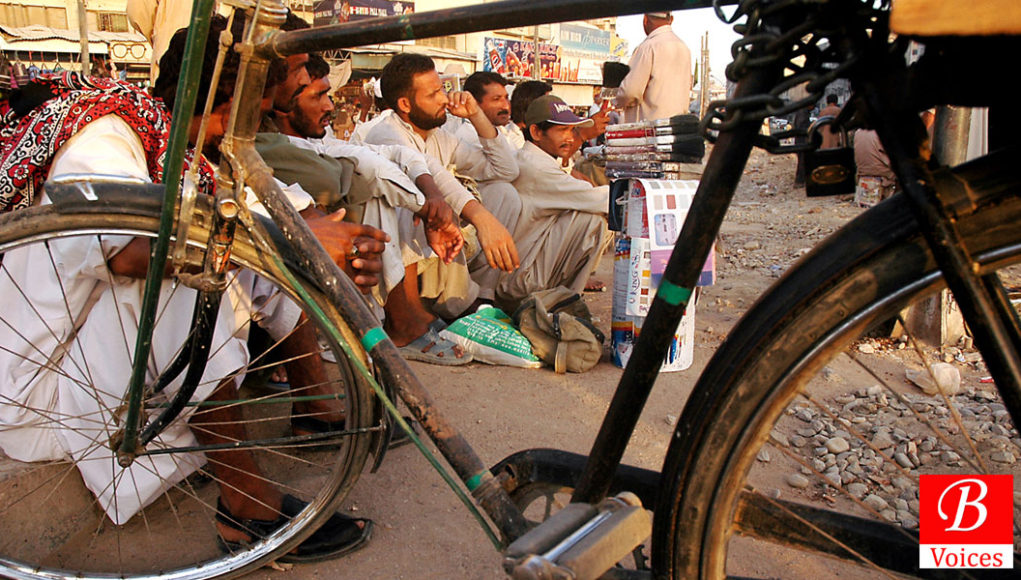 Arbaz Shah
Arbaz Shah
Shabana Jamal 45 has been stitching embroideries for nearly a decade, she got married in her 16 and gave birth to Rehman her first and only son two years after when she just reached eighteen.
Living in the mid-east of Huramzai a town in the Balochistan province of Pakistan with fifty thousand population in her small sized home she survives miserably with her husband Jamal, son Rehman, and two daughters Shumaila and Arifa, It takes her 10 days to fix an embroidery which she sends to market in capital city Quetta and earns 3,000 rupees of it.
“It is now difficult to carry our routine needs I hardly fill them, Before Jamal faced a road accident 4 years back which got him paralyzed on his left foot he would look after his family’s needs, He is now incapable of working so I am all on my own taking the weight and responsibility of the family on my shoulders. I can stitch 3 suits in a month which makes 9,000 rupees with which I spend the whole month, buying groceries for the kitchen and Jamal’s medicines take a high sum”.
Preparing those three embroideries seems now not possible, because, Shabana’s eyesight is getting feeble and her shoulders much weaker, she has never consulted a doctor for her health care because she cannot afford the expenses, said Shabana.
Jaweriya Najmu-Din was a bedridden woman living next door to Shabana’s home, she lay in bed for nearly five years and died in the same situation. She had been stitching embroideries for 12 years raising her five sons and falling into different diseases and unstable body conditions and even close to loss of her eyesight.
Around 100 women of the town stitch embroideries to carry the burdens of their families raising their kids and enduring the expenses of their schooling. In some cases, their husbands are not alive or unable to earn or unemployed to look after their families.
If they are given equal shares and recognition in the mainstream Pakistani markets, they would have benefitted the state treasury with high economic growth.
Their meal differs from others in society, simple home-baked bread with gravy, dates, and juice. Living a simple lifestyle and looking after her family, she works 10 hours a day sitting at home stitching Pashtun cultural embroideries and designing for earning. With weak eye-sight and poor physical strength, she still hopes she will earn adequate in this subsequent season of religious-eve Eid-Ul-Aza, which will bring joy for her 3 children and a paralyzed husband because the dress rate hikes 500 rupees when there comes to season.
According to the Pakistan Bureau of Statistics, the data collected on home-based workers indicate that there are 20 million home-based workers in the country of which 12 million are women who work to prepare cultural embroideries or other stuff to get connected to the market and earn bread for a living.
Managing his business sitting in the capital city Quetta Kareem Khan monthly receives embroideries from Shabana and many like her from Huramzai and around paying them a fixed sum. “I pay them 3,000 per suit and showcase that in the out-let, women come highly interested in purchasing hand-made cultural embroideries and pay a high amount for it”.
Sitting at home he helps them with utensils mirrors and other essential stuff, so that, they could make easy access to prepare the fabrics, said Kareem Khan out-let owner. “Since the Covid-19 eruption back in 2020 and the then call for border fencing left severe impacts on our businesses which also affected the home-based worker who sits at home and awaits our support. The tensions at the Afghan border are continued and we rarely find ways to get stuff from the border and facilitate the home-based workers to stitch the embroideries”.
According to reports published under the authority of the International Labor Organization (ILO), in a decade reportage from (2006/to 2015), “Pakistan is one of the Asian countries that have a large number of women engaged in home-based work and this sector has expanded at a fast pace. This expansion can be linked to the globalization of industry and the search for efficient means of production through low-cost labor. According to a World Bank study in February 2018, over 10 million women in Pakistan are engaged in home-based work in sectors like garment, bangle-making, shoe-stitching, embroidery, carpet weaving, etc. Despite their contribution to the economy being 60 percent, these women still do not have social and legal protection and are the most unprivileged among the society”.
Dr. Raheem Bugti Medical superintendent (Helper Hospital Quetta) is reserving expertise dealing with medical matters faced by home-based workers, He figures out that women working at home are faced with multiple postural problems that cause carpal tunnel syndrome, golfer elbow, rheumatoid arthritis, scoliosis jersey finger, and frozen shoulders.
Working in a still position stitching embroidery nearby her eyes also affect her eye-sight sharply which terms her ten-year reduction in her life-line, said Raheem.
Home-based workers are making their small businesses in high numbers, ILO has presented several proposals to the legislative assembly via its platform, we shall bring a motion into the matter and debate it on the floor of the respective assembly, as these women have been collaborating in marketing their works with their informal economy, said Shakila Naveen member Balochistan assembly.
The Pakistani authorities shall work with the ILO to strengthen the home-based workers by bringing them to formal mainstream marketing and to plan a strategy to bring ease to their work and facilitate home-based workers with medical care”.
A recent meeting was held on Nov 30, 2022, in a local hotel in Quetta in the nexus accommodation of Home Net Pakistan and UN-Women that debated the home-based workers and their generation of informal economy and their recognition. The guild was headed by deputy speaker of provincial assembly Babar Musa Khel who felt to frame a fledged policy to protocol recognition of home-based workers to let them participate in marketing and respecting their shares in the state economy.
Since we brought it into debate no such steps have been taken. I neglected one of the points presented by UN-women and Home Net Pakistan during a conversation that home-based workers will stick to paying a quarter of their earnings to the government treasury which I think is disparaging for their lower income to afford it, said Babar Musa Khel deputy speaker.
We are working in collaboration with the ILO to strengthen home-based workers. The International Labor Organization is instinctive to develop a plan for the implication that will be understanding the efforts made by home-based workers and help them with the incentives that they need according to the international human rights for home-based workers. The nexus between the government of Balochistan and the ILO will be bringing the home-based workers to mainstream Pakistani marketing which will help them earn adequate income to look after their families.
Currently, the government of Balochistan in collaboration with the ILO is going to start the assessment work for mainstreaming the home-based workers in Balochistan. “We are obsessing to bring innovative aspects in their work which could help them start modern day entrepreneurship for running an independent business and ILO will have been facilitating the unrecognized home-based workers for mainstreaming”. Added Babar Musa Khel.
If given proper recognition and healthcare, the home-based workers could deliver immense economic inputs to the state treasury with their informal economy generation.
Share your comments!








